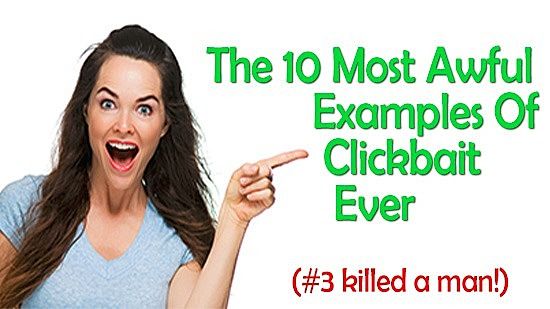An Absurd Reading of Clickbait
Matthew Crookes explores the cultural and philosophical aspects that underpin the rise - and rise, and rise - of online clickbait.
Matthew Crookes digs into the cultural and philosophical implications of online clickbait, and suggests an 'absurd' reading might serve as the best way to understand it.
Like many digital phenomena, clickbait’s evolved in concert with our own relationship with the internet. While column inches are devoted to the technological and marketing significance of clickbait, and to the science of web advertising in general, far less attention has been paid to it as a cultural or philosophical phenomenon.
My daily routine’s been restructured by my smartphone, and like many other people a greater part of my life is now lived online. In a rapidly evolving digital landscape, clickbait is a feature that’s emerged more or less by stealth. It possibly owes some of its technique to pop-up ads and spam emails, those well-known and fiendish sophisticated exercises in deception and entrapment (anyone remember the notorious ‘Drive Cleaner’ scareware of the mid to late noughties?). The frenetic tone of spam and pop-ups has doubtless influenced the language of the web. Clickbait headlines are a ubiquitous, and ultimately irritating, feature of the landscape. They get under your skin, intentionally.
There’s clearly more to clickbait than simply crummy stories hyped up; the sheer consistency in which promise is subsequently deflated by content points to a more deliberate and contrived phenomenon.
Clickbait operates at the level of an unconscious trigger; it’s a mechanism that activates a reflexive impulse. But in doing so it also throws up questions about the choices we make, and the measuredness of our responses when we’re browsing. We’re already aware that such irrational impulses have been exploited by advertisers, political campaigners and popular news media for decades. It also suggests that the impulses guiding our reception in other areas, like art galleries, or movies, are similarly emotive.
Clickbait isn’t necessarily about bad content, for then it would cease to be clickbait and instead at least provide a good laugh, even if unintended. It’s more a case of the ‘meh’ factor: in most cases, clickbait leads to content that’s simply unimaginative, predictable and utterly ordinary. There’s nothing offensive, except possibly the intrusive advertising, but the content is rarely captivating enough to stay with to the end.
The determinant of clickbait doesn’t rest in the content itself. It’s built by the space created by the emotive claims made in the headline, and the degree of disparity between the initial dramatic appeal of the headline and the banal character of the content: 15 Photos Of Parents And Their Kids At The Same Age Will STUN You or Unrecognizable! Cute Child Star to Ugly Adult, or even OMG. Best College in the World!
What differentiates online clickbait from earlier tabloid headlines is the degree of intensity, and hence the bathetic effect between the hyperbolic language and the indifferent content. Indeed, the content is secondary to the headline, which acquires a function and identity of its own. This is because of the massively accelerated turnover in the online environment and the increased volume of information. In such overheated forums, headlines must scream. It’s by this constant oscillation between anticipation and disappointment that clickbait is especially suited to an absurd reading.
As a cultural phenomenon, clickbait has already taken on some unique characteristics. One of the most apparent is a specialised use of language, which has evolved to perform a specific function. Such language – emotive, succinct and formulaic – has its roots in the sensationalist headlines of the popular newspapers that emerged in the latter part of the nineteenth century. These were themselves a response to a new mass-market, and a new mass-media revolution, in the form of a literate working class.
The new tabloid newspapers had circulations of several million each, and their style demanded new rules. Needing impact and limited by space, headlines employed conveniently concise terms like ‘bid’ and ‘vow’, friends were ‘pals’, champions were ‘heroes’. In comparison, where time and attention are the critical factors, clickbait headlines have given rise to emotive terms like ‘heart-melting’, ‘mind-blowing’ (or ‘blow your mind!’). Indeed, these terms have come to characterise clickbait. They have a long shelf-life, being used again and again, while managing to retain their impact. Perhaps because of this, one seldom encounters such overheated terms outside the context of online clickbait.
It’s possible to apply an absurd reading to this phenomenon when we consider this ‘curiosity gap’, the mechanism by which the invitation is more appealing than that to which it invites us. The absurd accounts for the curiosity gap because it provides for an element of doubt. It was originally described by Danish existentialist philosopher Soren Kierkegaard. In the course of outlining the notion of absurd, he asserted that belief and doubt are opposite passions. One doesn’t exist without the other, and if ‘belief’ initially draws you to something attractive, doubt keeps you from jumping in with both feet.
Doubt is a tempering influence, and as an illustration of its use as a tool for encountering the world, Kierkegaard gives us the ancient Greek skeptics. Doubt is that ‘yeah, right’ that goes through your head when you’re presented with yet another sensational claim – but not quite enough to reject it outright. Because of that, each time you’re presented with a headline containing the magic ‘trigger’ phrases, they act like self-contained units of invitation. What an absurd reading does is ask you to approach each clickbait headline as if for the first time, just as the Greek skeptics would have: to treat each encounter as a thing in itself and consider it as a relationship between the promise and the outcome. Belief draws you in, while doubt is the tempering tool – the thousand other times you’ve been disappointed don’t count here because this clickbait is new and untried!
Each clickbait headline exists independently of those around it, though they’re all trying to grab our attention and trigger a reaction. It’s up to us to decide whether to believe and to take up their claims (‘click on the link!’). Subjectivity allows for such a relationship. If we’re presented with a story that seems to promise drama, or some new insight, how many of us can honestly say we flatly turn away? When the story turns out to disappoint, or appears to enthuse about some non-event, we may be bemused, or annoyed, but neither our essential curiosity nor our desire for excitement will have been dulled.
The reason our curiosity sustains us from one clickbait story to the next can also be accounted for by the absurd. Social media engagement is, despite the name, a largely solitary and subjective activity. Subjectivity is the mother of belief and doubt. Kierkegaard described belief and doubt as opposing passions, not cognitive acts, nor two different kinds of knowledge. In other words, they’re gut reactions that play an important part in our online experience and behaviour.
Clickbait exists in an unresolved moment of bathos. Like a scratch-card lottery ticket, it’s poised on the cusp of a promise. The absence of immediacy is important to the mechanism. Our responses are instantaneous, but they are not themselves immediate. This element of mediation is essential, as it also gives rise to a feeling of detachment from what we’re seeing, which permits a disengaged response. Clickbait appeals to our sense of doubt: that we may miss out on something exciting, glamorous or otherwise life-enhancing. While one’s conscious, rational mind knows that in all likelihood whatever’s on the other side of the headline is of little or no consequence, the desire or craving, the fear of missing out – namely, the curiosity gap – overrides it.
An architecture of distraction and urgency is good for business, and the web is, after all, privately owned.
When we’re left with just our own experience and judgement, we’re obliged to accept a degree of faith. Faith is internalised, and shaped by our worldly experience. In the environment of social media, you’re offered the illusion of creating your own world. Yet we only have the evidence of what’s on the screen to act upon, and can’t bear witness to the hidden algorithms and machine decisions that shape our shared experience. This tension between doubt and belief underpins our relationship with social media: we’ve grown wise to many of its tricks and deceptions, but we still maintain sufficient faith to return time and again. There’s no reliable way of confirming whether any content online is definitely genuine, and that doubt extends to any testimonials and endorsements.
This doubt extends to the providers themselves. Does anyone put their unqualified trust in Facebook or Google? We only have our own judgement and experience, and must assess whether any given item appears plausible. It’s at this point that an act of faith begins, and the degree of plausibility to satisfy each person will differ. Moments of such judgement occur dozens, hundreds of times each day.
An element of doubt and insecurity can be a useful tool when negotiating clickbait, and for keeping in mind its mechanism and affect. In the purely subjective world of social media, doubt maintains a crucial question mark above all the decisions we make. Doubt gives rise to all those questions we should be asking ourselves (but forget to) while we’re online; is the headline/organisation/petition what it claims to be? Where did they get those ten or five or six examples from? Amazing/mind-blowing compared to what? Where did the stats/data/study come from? Is there a vested interest (who owns the platform)? Is this a serious endeavour? Will I be better or worse of for this encounter? Who’s buying and selling my data and to what ends? Will I remember this encounter with gladness or regret?
The fact that we do none of these while engaging is, of course, due to the speed and volume of material passing before us during the day. An architecture of distraction and urgency is good for business, and the web is, after all, privately owned. In the context of an absurd reading of clickbait, this means in fact that we become quite capable of a constant renewed expectation with each item we’re presented with – a kind of self-imposed amnesia, grounded in subjectivity and doubt.
Whether or not viewers spend any time with the content is largely irrelevant, since rates of advertising are calculated on raw clicks alone, the ‘one click, one reading’ rule. One seldom learns anything new in these blogs, and any genuinely worthwhile content will have been sequestered behind a paywall. Logically, one would expect a law of diminishing returns, a constant ramping-up of the tone of the language for an increasingly jaded and unenthusiastic response. But this doesn’t seem to be the case, and the phenomenon has been noted for several years now. Norwegian web developer Lars Eidnes on his blog discussed a new program for generating clickbait language:
“...2,000,000 headlines, scraped from Buzzfeed, Gawker, Jezebel, Huffington Post and Upworthy. How realistic can we expect this model to be? Even if it can learn to generate text with correct syntax and grammar, it surely can’t produce headlines that contain any new knowledge of the real world? It can’t do reporting? Maybe true, but it’s not clear that clickbait needs to have any relation to the real world in order to be successful.”
As a technical account of the process, one focused on the mechanism as a neurological phenomenon rather than making a moral or ethical judgement, this is very telling. From the get-go, it’s understood that clickbait functions in an area quite distinct from imparting information, recognizing that it acts upon an emotional reflex. Psychologists who work with the advertising industry refer to this process as ‘expectation management’, a principle that’s applied not simply to the content of adverts, but also to the structure of a blog itself, and the length, complexity and frequency of posts.
Listicles are ideally suited to the medium of clickbait, as they’re quickly researched and can be used to recycle material endlessly, offering the appearance of variety even if they merely repost or plagiarise other, similar posts. The list format itself is labour-saving, and makes few demands either on the author or the reader. Once the idea for an initial list has been dreamt up (or appropriated and modified), the task of filling in content is fairly straightforward. The listicle provides catchy, shouty filler for little effort, and it’s very cheap. So you get things like this, or this, or even this (‘art might be something you want to do in your spare time while you pursue a degree in a field that makes more financial sense’).
At no point in its production or consumption is there much need for reflection or original thought; indeed it reframes the whole notion of authorship, since the component parts of any listicle are standardized, and in many instances interchangeable. Adherence to a house style neutralises any individual voice within the text of the pieces. As a format, it appears to anticipate a time when content will indeed be completely automated.
The original skeptics of ancient Greece based their philosophy, and their approach to the world, on doubt. By that it should be understood that they were never unbelievers, but rather that they subjected everything they encountered to a process of scrutiny, which accepted nothing at face value. Anything, whether it was a stick perceived through the distorting effects of water, the shape of an object seen in the distance, or the promise of a sensational secret or piece of gossip, was not accepted until it had been weighed against doubt. With no other means of judging value and veracity than their own subjective knowledge and experience, doubt was a useful tool. It enabled the skeptics to maintain an open and reserved judgement. Doubt exists as a counterbalance to unquestioning belief. The skeptics referred to it as metriopatheia, a moderation of passion, and doubted not on account of their knowledge, but as an act of will in itself. In other words, they chose to doubt, and any subsequent decision was grounded in this conscious choice.
In its strictest sense then, a skeptic’s approach to clickbait would certainly not be a dismissive one. It would be one of holding each clickbait to the same standard of proof on each occasion. So although in the past a cat falling from a tree has failed to ‘melt my heart’, or a TV star proving to be older than the roles he or she plays has not ‘blown my mind’, this knowledge is no basis to doubt the claims of any subsequent clickbait. The skeptic approaches prepared both to believe by clicking on the link and to apply doubt, and so tempers any hopes beyond the (most likely) outcome.
An absurd, skeptical approach to clickbait can enhance our experience – particularly when we’re aware of the effects of the mechanism at work, and the tricks being played on us. It’s perfectly possible to enjoy a world of cute animals, minor celebrities and ‘shocking’ revelations as undemanding entertainment, and because one day, like playing the scratch cards, you may just hit upon the story that changes your life.




